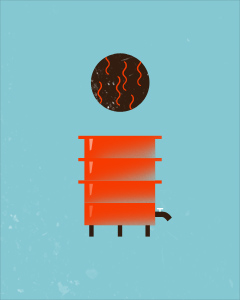 Uneaten food isn’t garbage, it’s organic waste. But when treated like garbage and sent to a landfill, the waste releases methane, a greenhouse gas 21 times more potent than carbon.
Uneaten food isn’t garbage, it’s organic waste. But when treated like garbage and sent to a landfill, the waste releases methane, a greenhouse gas 21 times more potent than carbon.
Even if global warming weren’t a menace, treating old food like trash would still be a missed opportunity of epic proportions. When organic waste is properly handled, the result—compost—is pure magic. Will Allen, the visionary behind Growing Power urban farm in Milwaukee, swears that with compost, gardening is as easy as throwing seeds over your shoulder. It’s that rich with nutrients.
Here in Philadelphia we’re beginning to wake up to the possibilities composting offers. In this section we’ll introduce you to three common methods of composting to help you decide how to do it yourself. We’ll talk about new technologies, and classic books that will answer your composting questions. And we’ll introduce you to four businesses—two haulers and two processing facilities—that have recognized that in our heaps of waste, jobs can be found.
Across the city Philadelphians have started composting, in backyards and kitchens, even restaurants and hotels. The number is growing every day. So here’s the call to arms, from GRID to you: Start composting! It’s good for your garden, great for the environment, and an easy way to be a more sustainable citizen.
Composting 101
So, you’ve realized that you’ve got a goldmine, right there in your garbage can! And you aren’t going to let it go to waste, or even to Waste Management. But before you take the plunge, it’s important to know that there’s more than one way to compost a canteloupe. Any method will get the job done. They all require air, water, heat, the right-sized space—and, of course, your apple cores and dry leaves to provide nitrogen and carbon. But it’s best to consider where you live before you choose a method.
We begin with an overview of three common ways to compost. The books reviewed on page 35 offer more in-depth directions, and local composting workshops can provide hands-on experience. Primex, a garden center in Glenside, Pa., holds composting workshops in early spring (typically March and April). They’re also a great resource for finding out about composting workshops happening all over the Greater Philadelphia area. To find out more visit their website (primexgardencenter.com) or give them a call (215.887.7500).
 illustrations by melissa mcfeeters1. Vermicomposting
illustrations by melissa mcfeeters1. Vermicomposting
Perhaps the most realistic solution for the apartment dweller, vermicomposting uses worms to break down food waste. This method can be done indoors and with limited space. But don’t collect earthworms from your backyard just yet; vermicomposting relies on redworms, distinguished by their red and buff-colored stripes. Unlike earthworms, which like soil, redworms prefer compost and manure environments. Redworms also produce castings (a polite name for manure) that contain beneficial microbes and nutrients that help make an ideal plant fertilizer.
Redworms cost about $25 per pound, and the other materials needed—a container and bedding—are inexpensive. Vermicomposting can be done in wooden or plastic bins. Wooden bins have better insulation and are more absorbent, while plastic is easier to clean and maintain. Holes are made for aeration and drainage, and a lid is added since worms like darkness. Bin size is critical to ensure the worms get enough to eat. Ideal bins provide one square foot of surface area per pound of waste generated. Since redworms are surface feeders, bin depth should be between eight and 12 inches. Two pounds of worms will recycle a pound of food waste in 24 hours.
In vermicomposting, food scraps are added to a bedding of shredded newspaper, cardboard, peat moss or aged grass clippings. Food waste is buried in rotating locations within the bin to ensure efficient and complete composting. It’s important to exclude bones, dairy and meat products, as well as spicy foods, garlic and onions. Once the bedding disappears, the worms can be moved to new bedding and the compost can be harvested. For more on vermicomposting, check out Worms Eat My Garbage by Mary Appelhof.
Pros: Small, kept inside, pet worms!
If done wrong: Fruit flies, odors, added guilt of dead worms
 2. Aerated Static Pile
2. Aerated Static Pile
If you have a backyard, you might consider the classic composting method, the aerated static pile. The easiest way to compost is to simply pile food and yard waste, water the heap and wait. Since this “casual” pile won’t get hot—that happens when you move or “turn” the pile—decomposition takes longer. Food waste should be buried toward the bottom of piles covered by yard waste, wood or finished compost to control odors and deter pests.
Compost piles can also be placed in bins, which contain the waste and protect from pests and weather. Bins made from snow fence and woven wire are easy to build, move and store, as well as economical. Block bins can be made with cement or rocks. No mortar is required, and leaving spaces between blocks or rocks allows for aeration. Wooden pallets also make great bins.
Another slightly more effort-intensive option is using a series of bins. Users turn the materials, usually with a shovel, and move them from one bin to another. Turning bins are ideal for individuals with lots of yard trimmings and an interest in making high-quality compost.
For the avid composter, there are pile methods with specific layering and turning techniques, which make more predictable, higher quality compost. The Rodale Book of Composting is a great resource for these methods.
Pros: Requires minimal work, inexpensive
If done wrong: Odors, pests
 3. In-Vessel
3. In-Vessel
This is the easiest of the composting methods. Users add compost to an enclosed cabinet or drum that either manually or mechanically turns, and within a few weeks have usable compost. There’s a wide range of technologies to choose from, and finding the right one will depend on your household’s needs.
In-vessel composting can be done indoors or outdoors, and can be ideal for small backyards and apartments. With an enclosed system the composting process and its odors are easily controlled. Many models are mounted on stands with hand cranks that make daily turning easy. And with an enclosed system and regular turning, the composting timeline is shorter.
There are many effective compost tumblers and bins on the market, and they typically begin at $150.
Pros: No odors, requires minimal work, can be inside or outside, small
Cons: Expensive
What Should I Compost?
Cardboard
Clean paper
Coffee grounds & filters
Corncobs
Cotton rags
Dryer & vacuum cleaner lint
Eggshells
Fireplace ashes
Flowers
Fruits & vegetables
Grass clippings
Hair and fur
Hay and straw
Houseplants
Leaves
Pine needles
Newspaper
Nut shells
Sawdust
Tea bags
Wood chips
Wool rags
Yard trimmings
Avoid
Fats, grease, lard, or oils
Coal or charcoal ash
Dairy products (e.g., butter, egg yolks, milk, sour cream, yogurt)
Black walnut tree leaves or twigs
Diseased or insect-ridden plants
Meat or fish bones and scraps
Pet wastes (e.g., dog or cat feces, soiled cat litter)
Yard trimmings treated with chemicals
– Liz Pacheco



Where is a good place to buy a Composting barrel in the Philly area?
Where is a good place to buy a Composting barrel in the Philly area?
Vermicomposting is considered one of a kind recycling of its kind !
Vermicomposting is considered one of a kind recycling of its kind !
Saw should you exclude treated lumber?